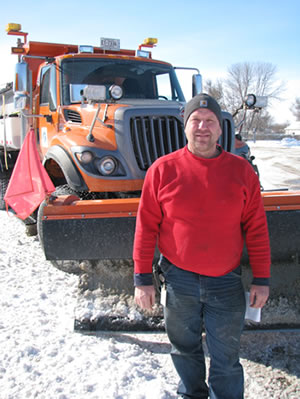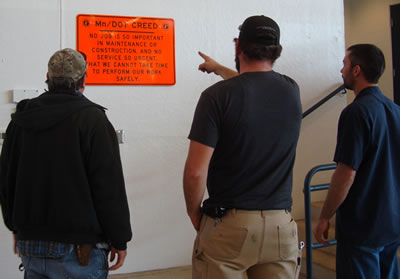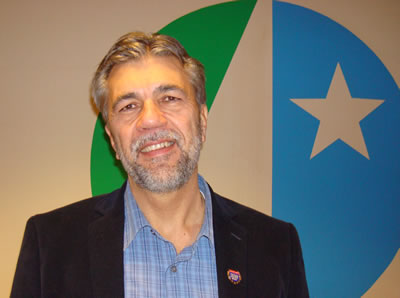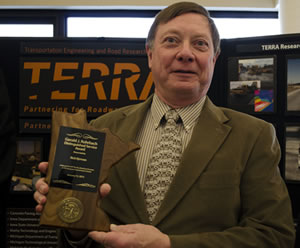 |
|

|
 |
TABLE of CONTENTS
 |
Detroit Lakes teams help deliver pregnant woman to hospital, rescue family stranded by storm |
By Jerimiah Moerke, District 4/Detroit Lakes public affairs coordinator

In other action during the Feb. 10-11 storm in west central Minnesota, Todd Meyer (above), District 4 transportation generalist, and State Patrol Sergeant Jesse Grabow rescued a family of four stranded in their car for six hours. The family got stuck near Wolverton, south of Moorhead, that Sunday morning. Meyer plowed through a solid foot-and-a-half to two feet of snow to reach them. Meyer and Grabow were able to get them home safely that night. Photo by Jerimiah Moerke
|
It took a team effort to get a stranded woman who was in labor to the hospital during the Feb 10-11 storm.
Around midnight Feb. 10, Matt Anderson, transportation generalist senior, was plowing Hwy 59 north of Detroit Lakes when he got a call about a mother-to-be stuck in an ambulance east of Mahnomen.
Anderson said conditions were so poor it would take at least two hours to reach her.
“You could only go 15 miles an hour,” Anderson said.
Luckily Dean Kroulik, transportation generalist, decided to spend the night in the Mahnomen truck station in advance of his 3 a.m. shift.
“I heard my phone start buzzing,” Kroulik said about his early wake-up call.
Kroulik answered the call and quickly got into his plow. He cleared a path on Hwy 200, which allowed the ambulance to head back into town.
In the meantime, Anderson had made it to Mahnomen and was ready to lead the ambulance to Detroit Lakes. Several other drivers also were alerted to prepare a path in case an ambulance run was needed between Detroit Lakes and Fargo.
“It was a whole array of people involved in this,” Anderson said.
In the end, the mother made it safely to the Detroit Lakes hospital, where she gave birth to healthy twins. |
 |
|

|
 |
TABLE of CONTENTS
 |
Fighting snow: behind the wheel of a snowplow |
Through the years, snow plow drivers across the state have consistently delivered on helping keep Minnesota roads open in the winter. But every once in a while, a storm hits that brings work to a standstill. On Feb. 10, MnDOT pulled plows from roads in west central Minnesota when blowing snow made I-94 and several highways impassable. Here’s some footage of a couple plows during that storm. District 3/Baxter plow driver Kraig Johnson, transportation generalist, took videographer Gary Andrist on his route to see the kinds of conditions plow drivers often face. This video will be pushed out through social media to prep motorists for driving safely during the next storm.
Video by Gary Andrist; narrated by Pam Newsome
|
|
 |
|

|
 |
TABLE of CONTENTS
 |
MnSAFE brainstorming event yields several ideas, direction for committee |
|
By Jessica Wiens

From left, Brian Meyers, Preston Truck Station; Tony Bale, Rochester Bridge; and Tom Fort, Rochester Shop, reflect on MnDOT’s safety creed. It states: “No job is so important in maintenance or construction and no service so urgent that we cannot take the time to perform our work safely.” District safety administrators are currently posting the safety creed in each MnDOT truck station across the state. Photo by Kristin Kammueller
|
More than 1,000 MnDOT employees participated in the MnSAFE brainstorming event in October about workplace safety. The committee gathered ideas through individual online comments and group discussions. The brainstorming event focused on how to prevent the primary causes of workplace injuries—slips/trips/falls and overexertion.
“We sorted through thousands of comments,” said Todd Haglin, safety director and chair of the MnSAFE committee. “A key part of meeting our goal to reduce workplace injuries by 25 percent requires employees to take personal responsibility for their safety and ask for help when they need it.”
One major area for improvement is reducing slips and falls while getting in and out of equipment. Since July, seven MnDOT employees suffered injuries in this manner. Prior to that, four employees were injured in fiscal year 2012 and 11 employees in fiscal year 2011 while getting in or out of equipment.
“These can be avoided if employees use the three-point contact rule at all times,” said Haglin. “That means three of your four hands and feet are in contact with the vehicle or equipment at all times.”
Rod Starky, District 2 safety administrator, started an effort to place reminder stickers on all vehicles that require climbing in and out. This practice is expanding across the state, so field employees soon should notice these stickers on equipment and posters in common areas with further information.
Other key areas from the brainstorming event the committee identified include:
- Sharing best practices: Many truck stations and offices are already using best practices for reducing overexertion, but those ideas are not getting communicated to a wider range of employees. The MnSAFE committee plans to set up a process for employees to share best practices and ideas with their safety administrator, who can then forward to others across the agency.
- Housekeeping: Several comments were about improving cleanliness of work spaces. The MnSAFE committee hopes to work with managers and supervisors to do regular spot inspections of work areas and discuss positive and negative examples of safe, clean work spaces.
- Indoor/outdoor walking surfaces: Employees asked for better maintenance of indoor/outdoor walking surfaces to ensure they are clean, dry and safe to walk on to help eliminate slips, trips and falls. The committee will look into how to accomplish this.
- Wellness/exercise programs: Many employees requested more comprehensive wellness and exercise programs. The committee is looking into how to facilitate this statewide, including the MnSTEP stretching program.
MnSAFE is a statewide workplace safety initiative for Minnesota state employees. Gov. Mark Dayton has challenged all state agencies to reduce the rate of workplace injuries 25 percent by fiscal year 2014. More information is at http://mn.gov/mnsafe/. |
 |
|

|
 |
TABLE of CONTENTS
 |
Senate confirms Charlie Zelle as MnDOT commissioner |

Charlie Zelle. Photo by David Gonzalez |
Charlie Zelle officially became the state's newest transportation commissioner when the full Senate confirmed his appointment on Feb.7.
"Transportation is the bedrock of the economy, for jobs and prosperity," Zelle told the Senate Transportation and Public Safety Committee at its Jan. 28 hearing, the first round in his confirmation process.
To ensure that there would be no conflict of interest between his new job and his former job as president and CEO of Jefferson Lines, Zelle signed a statement saying that he was stepping away from managing the Minneapolis-based transportation company and would recuse himself from any MnDOT decisions that might affect the company. |
 |
|

|
 |
TABLE of CONTENTS
 |
Jeff Vlaminck named District 6 engineer |
|
By Kristin Kammueller, District 6/Rochester public affairs coordinator

Jeff Vlaminck took the reins as District 6's new transportation engineer Feb. 11. He succeeds Nelrae Succio, who retired in January. Photo by Kristin Kammueller |
Jeff Vlaminck has been selected to serve as district engineer for District 6, which includes 11 counties in southeastern Minnesota. The district has offices in Rochester, Owatonna and Winona.
Vlaminck began his new role Feb. 11 and succeeds Nelrae Succio, who retired Jan. 3.
Vlaminck has been with MnDOT for 36 years. His most recent position was assistant district engineer for East Operations in District 6. In this role, he supervised district maintenance and construction activities. Prior to that, he held leadership positions in construction, design and project delivery.
A native of Willmar, Vlaminck has a civil engineering degree from the University of Minnesota.
In his new position, Vlaminck will be responsible for more than 1,400 miles of state and federal highways, 376 employees, an annual construction budget of $98 million and an operating budget of $37 million.
For more information on MnDOT District 6, go to www.dot.state.mn.us/d6/. |
 |
|

|
 |
TABLE of CONTENTS
 |
State Aidís Rick Kjonaas honored for contributions to pavement engineering field |
By Nick Busse, Research Services

Rick Kjonaas, deputy state aid engineer, was recognized at the annual at the TERRA Pavement Conference Feb.14 for his contributions to the field of pavement engineering. Photo by Michael McCarthy, Center for Transportation Studies |
Deputy State Aid Engineer Rick Kjonaas received the Gerald J. Rohrbach Distinguished Service Award on Feb. 14. The award honors individuals who made significant contributions to the field of pavement engineering.
The award is presented annually at the Transportation Engineering and Road Research Alliance Pavement Conference, which provides education and training opportunities for pavement professionals. Videos and presentations from this year’s conference, including several from MnDOT staff, are available online.
The award is named for Gerald “Gerry” Rohrbach, who served as MnDOT’s director of materials and road research until his retirement in 2002.
|
 |
|
| |
|



